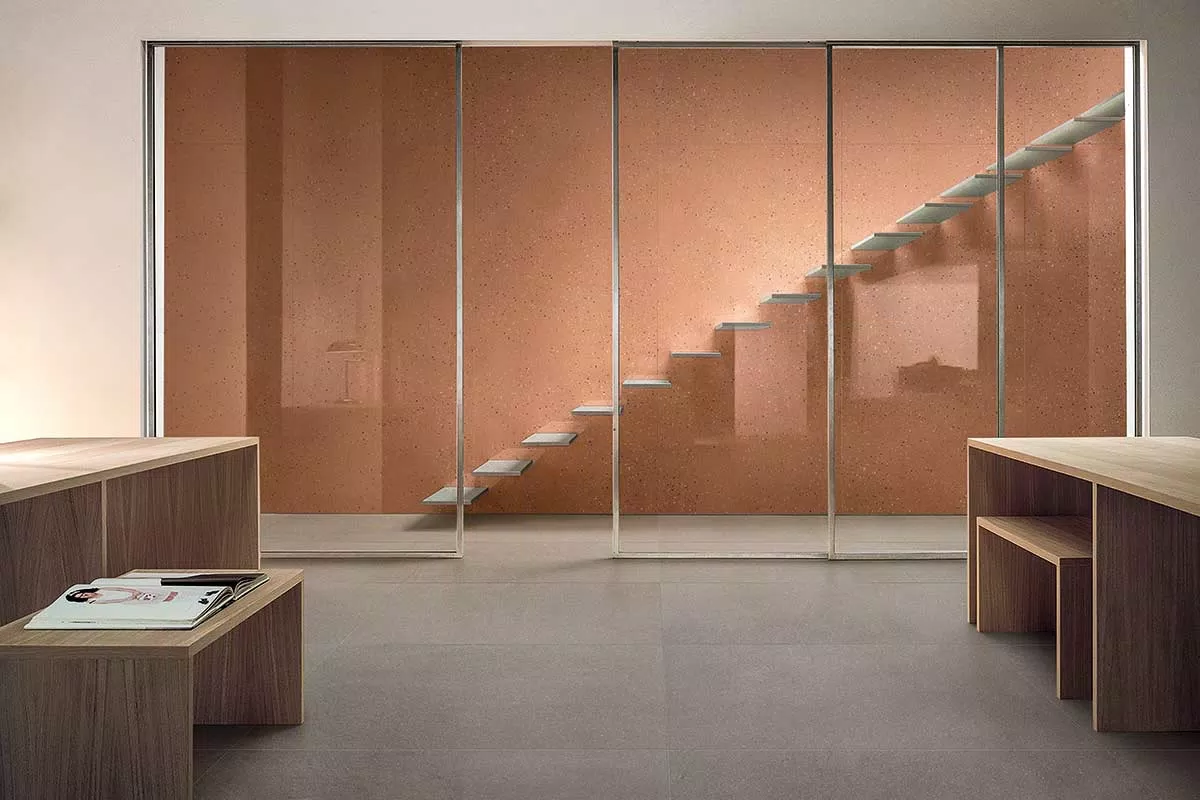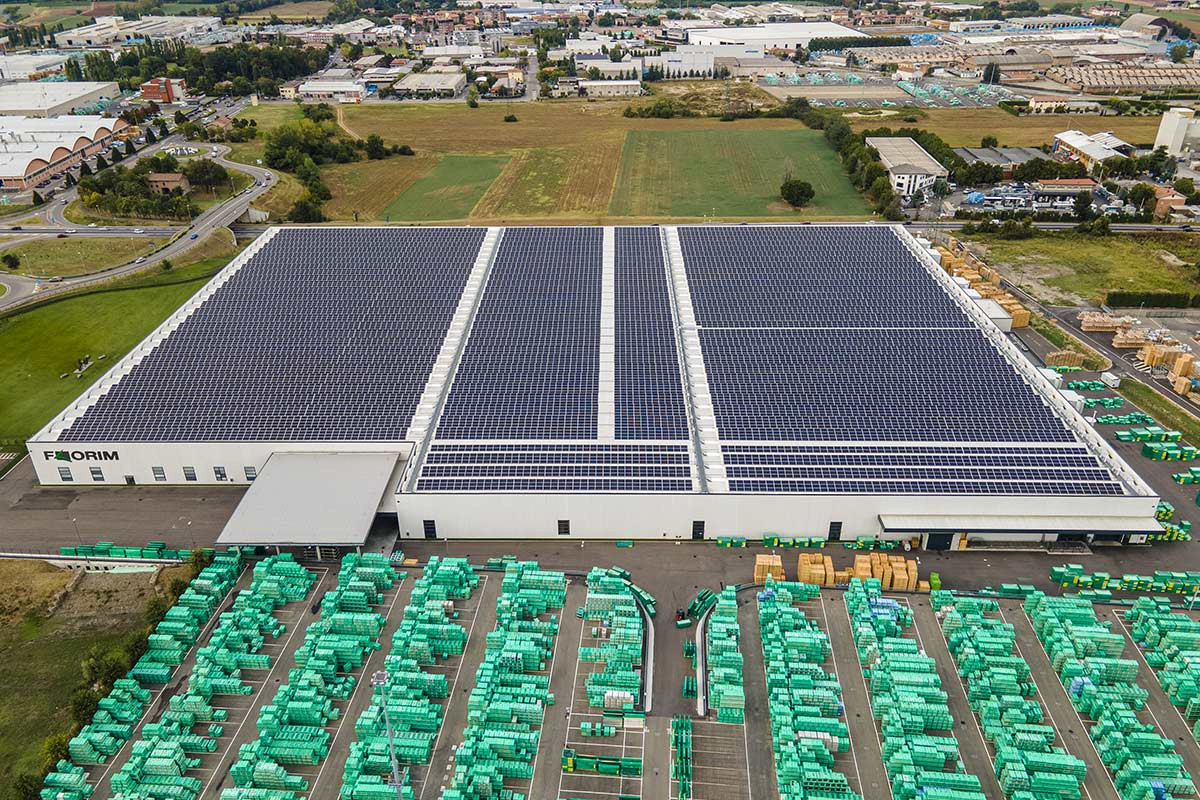We are more and more convicted that the world of surfaces continually needs to create and offer new aesthetic ideas. However, innovation, more and more strongly influenced by the drivers of sustainability, often responds mainly to the demand for new performances, or the needs of new lifestyles, and derives its evolution from production processes.
The production plants that give identity to materials are always a key factor when designing innovations, as are the relative processes. And it is in the transformation of these areas that genuine change is often achieved.
From sustainability as well as other points of view, the production phase is the most important part of materials’ entire life cycle, and it is also the one over which the company can exercise the greatest control.
In fact, by using renewable energy sources and leading-edge technologies, producer companies are able to achieve outstanding environmental impact reduction performances.
The most significant environmental indicators for the production cycle are:
- raw material use (waste avoidance);
- water use;
- energy use;
- atmospheric emissions;
- production scrap generation;
- noise emissions.
Achieving sustainability for all materials
During the last few years, we have seen the birth and trialing of many construction materials and components made from waste products. Examples include textiles made by recycling fishing nets, or the recovery of citrus processing waste. Insulating materials and plasters produced by recycling rice processing byproducts, or using cork or hemp.
Concrete, a mineral material, is also now available in a recycled version, which is catalytical and “eats” smog, giving it great potential for architecture. Gypsum plaster, also obtained from a natural mineral material, has been part of the Italian decorative tradition for hundreds of years, and recently we have seen the introduction of innovative lightweight decorative panels, made by state-of-the-art casting techniques.
Even plastics are appearing in new forms throughout buildings’ lifecycle (recycled in durable, easily recyclable insulation materials for many construction systems), although buildings and furniture play only a very minor role in the immense challenge of reducing their consumption.
Timber, like concrete, is increasingly widely used in building techniques. We find it in the coverings of floors and walls but also in the form of prefabricated panels for load-bearing structures, roofs and external claddings, right through to whole prefabricated systems for building even multi-floor homes. Compared to other technologies, timber provides very fast, dry, safe construction; as well as being easily recycled at end-of-life, wooden buildings guarantee rapid recouping of the property investment, with positive effects for projects’ economic sustainability.
Bricks also confirm the value of their ancient construction tradition and their sustainability, brought up to date in insulated versions for highly energy-efficient buildings, lightweight for new applications, or even new wall and floor covering elements.
Last but not least ceramics, of mineral origin, confirm their status as one of the best-performing, sustainable products of the entire universe of surface coverings currently available.

Earthtech/ Collection
find out more
Ceramics have achieved sustainability thanks to lengthy research and innovation work on production processes, which has resulted in controlled use of natural resources and ever-improving energy saving, while maintaining all the products’ outstanding technical performances.
However, as well as control of raw materials, real sustainability is measured throughout materials’ entire life cycle, considering their average lifetime and durability, disposal and recycling.
Product selection must consider the life cycle
Life Cycle Thinking means considering products – and the processes by which they are manufactured – throughout their life cycle.
This approach underlies the European Union’s new environmental policies and many other initiatives, ranging from Green Procurement to the development of Best Available Techniques (BAT).
The operating tool of Life Cycle Thinking is the LCA (Life Cycle Assessment), which provides a systemic view of production processes and products. The assessment is made by following, step by step, the sequence leading from raw material extraction through all transformation and transportation activities and – after the product’s useful life in the form of an economic asset – to return to the land in the form of waste.
However, rather than the individual product, a life cycle assessment should evaluate the whole building system, considering its energy consumption in all its phases:
- during the construction phase
- for the production of construction materials and components;
- for transportation of materials from the production facilities to the building site;
- for construction as such;
- during the operating phase
- for heating,
- for hot water production,
- for the overall management of the building
- in the demolition and disposal phase
- building demolition process;
- positive input from the recycling of materials and components.
Therefore, when choosing the materials and components for a project, every single element’s interrelations with the building’s system must be identified and its role in the overall energy balance must be assessed.
Choosing ceramics forms part of a correct design approach, which considers the work’s entire life cycle, the only possible vision for a responsible attitude to the future of the spaces and territories where we live.
Porcelain stoneware’s mineral origin and low impact processes
A product’s life cycle assessment starts from the extraction and processing of the raw materials. Stoneware slabs are manufactured using clays, feldspar sands and quartz sands, all materials common in the Earth’s crust and not at risk of running out, unlike some kinds of stone.
In accordance with the legislation of all producer countries, quarry extraction and remediation plans are in place to avoid radical changes to the landscape and to ensure the rewooding of large areas.
| A Unlike that of other natural materials such as stone or timber, the production of Made in Florim porcelain stoneware has no significant impacts on territorial biodiversity, since the company is located at Fiorano Modenese, in the Sassuolo ceramics district. Great care is taken over the selection of suppliers of the raw materials used in tile body mixes, who are required to cooperate with the company in fully protecting ecosystems and biodiversity. Florim has also activated a digital platform for the management of raw material origin data (quarry location, distance from the factory, technical datasheets, etc.). |

Florim raw materials
The environmental benefits of using stoneware
The strong points of stoneware production are:
• Use of natural raw materials with low environmental impact;
• Production process with high quality and environmental performances;
• Lower drinking water consumption;
• Less generation of scrap and offcuts during processing and optimal scrap recycling;
• Durability of surfaces over time, with no particular maintenance needs;
• Low environmental impact in case of removal of materials and landfill disposal.
Water is a fundamental ingredient in production, used both as a tile body raw material and for washing plants.
| At Florim there are no environmental impacts from wastewater discharges since all the water from the production cycle is reused. The Fiorano site has also installed a rainwater collection tank which recovers rainwater and optimizes its use as a water source by feeding it into the production process. The only water not recycled is that utilized for the company’s washrooms and kitchens. Florim has been working hard to reduce the environmental impact of its production operations for many years. This has and continues to be possible thanks to the use of its research laboratories, the many skills of its employees and continual investments. In the last six years, the company has invested over 40 million Euro in the protection of the environment and resources. From the new photovoltaic plant to the new scrap recovery processes, the company has managed to keep its use of resources down in spite of the growth in output. |
-jpg.jpg/?quality=80&format=webp&scalemode=centered&dpr=100)
Florim | Factory 4.0 – Plant 2 (Fiorano Modenese – MO)
All waste product is optimized
Another important aspect of a production system is the generation of processing waste. Waste fired material, whether originating as production scrap or from demolition, is classified as an aggregate by current legislation, and its chemical inertia is confirmed by laboratory tests. Thanks to its geotechnical and environmental characteristics, it can be reused in construction and road-building projects as an alternative to quarried hard core.
In spite of this option, Florim recycles and optimizes, within the production process, all greenware scraps, dust residues from filters and sludge from the process wastewater treatment system. It also recycles waste produced by third parties.




